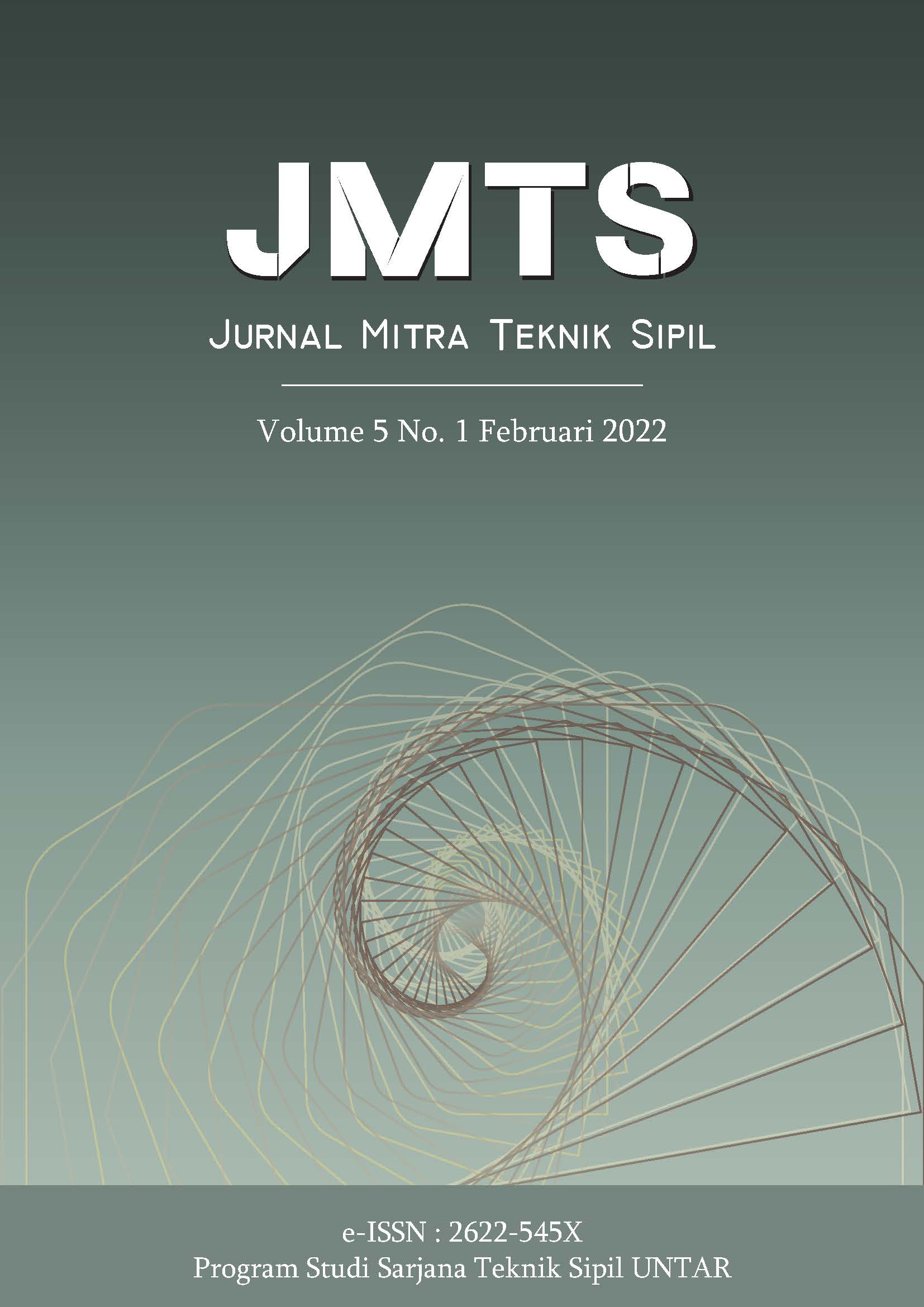PERILAKU KEGAGALAN KONSTRUKSI JALAN RAYA YANG BERTUMPU PADA FONDASI TIANG DI TANAH CLAY SHALE
Main Article Content
Abstract
Clay shale has unique mechanical properties compared to other soil types. When dry and undisturbed, clay shale will shrink and resemble hard rock. When the clay shale layer exposes to air and water, it will expand and experience weathering that causes its shear strength to decrease drastically. This research aimed to analyze highway construction that requires strengthening the pile foundation and found a layer of clay shale. The shear strength of clay shale can be reduced by 20% – 80% when exposed to air and water. This study assumes that the clay shale has reduced shear strength due to weathering by 50%. The displacement analysis will use the MIDAS GTS NX program. The results of the axial bearing capacity of the pile with a diameter of 0,8 m and a length of 8 m before the shear strength reduction was 47 tons, while after the shear strength reduction was 33 tons. It needs five piles to carry the design load, whereas if the clay shale's shear strength is 100%, it only needs four. The results of the analysis of highway displacement without pile reinforcement are 50 mm, and it would be 30 mm if the roads are using the pile reinforcement.
Clay shale memiliki sifat mekanis yang unik dibandingkan dengan jenis tanah lainnya. Ketika dalam kondisi kering dan tidak terganggu, clay shale akan menyusut dan sifatnya menyerupai batuan yang sangat keras. Ketika lapisan clay shale terekspos oleh udara dan air maka clay shale akan mengembang dan mengalami pelapukan yang menyebabkan kekuatan gesernya menurun secara drastis. Penulisan ini akan membahas konstruksi jalan raya yang memerlukan perkuatan fondasi tiang dan ditemukan lapisan clay shale. Kuat geser clay shale dapat tereduksi sebesar 20% – 80% bila terekspos udara dan air. Pada studi ini, diasumsikan clay shale mengalami reduksi kuat geser akibat pelapukan sebesar 50%. Analisis displacement akan menggunakan program MIDAS GTS NX. Hasil daya dukung aksial tiang dengan diameter 0,8 m dan panjang 8 m sebelum reduksi kuat geser sebesar 47 ton, sedangkan sesudah reduksi kuat geser sebesar 33 ton. Oleh karena itu diperlukan 5 buah tiang pancang untuk memikul beban rencana, sedangkan jika kuat geser clay shale tidak direduksi akan dibutuhkan hanya 4 buah tiang pancang. Hasil analisis displacement jalan raya tanpa perkuatan tiang pancang sebesar 50 mm dan displacement ketika menggunakan perkuatan tiang pancang sebesar 30 mm.
Article Details
References
Alatas, I. M., Kamaruddin, S. A., Nazir, R., Irsyam, M., & Himawan, A. (2015). Shear Strength Degradation of Semarang Bawen Clay Shale Due to Weathering Process. Jurnal Teknologi (Sciences & Engineering), 109-118.
Das, B. M. (2014). Principles of Foundation Engineering (8th ed.). Boston: Cengage Learning.
Das, B. M., & Sobhan, K. (2014). Principle of Geotechnical Engineering (8th ed.). Stamford: Global Engineering.
Gartung, E. (1986). Excavation in hard clays of the Keuper Formation. Proceedings of Symposium, Geotechnical Engineering Division.
Hardiyatmo, H. C. (2008). Teknik Fondasi 2 (4th ed.).
Hardiyatmo, H. C. (2011). Analisis dan Perancangan Fondasi (2nd ed.). Yogyakarta: Gadjah Mada University Press.
Meyerhof, G. G. (1976). Bearing Capacity and Settlement of Pile Foundations. Journal of the Geotechnical Engineering Division, 102, 197-228.
Nasional, B. S. (2017). SNI 8460:2017 Persyaratan Perancangan Geoteknik. Jakarta: Badan Standarisasi Nasional.
Oktaviani, R., Raharjo, P. P., & Sadisun, I. A. (2018). Kajian Ketahanan Batuan Clay Shale Formasi Jatiluhur di Sentul City. Promine Journal, 26-32.
Rolls, D., & Bland, W. (1998). Weathering: An Introduction to Scientific Principles (1st ed.). London: Hodder Arnold.
Schaefer, V. R., & Birchmier, M. A. (2013). Mechanisms of Strength Loss during Wetting and Drying of Pierre Shale. Paris: Proceedings of the 18th International Conference on Soil Mechanics and Geotechnical Engineering.
Soetojo, M. (2009). Teknik Pondasi pada Lapisan Batuan. Surabaya: ITS Press.
Stark, T. D., & Duncan, J. M. (1991). Mechanism of strength loss in stiff clays. Journal of Geotechnical Engineering, Vol. 117, No. 1.
Tantra, H., & Prihatiningsih, A. (2019). Analisis Kuat Geser Tanah Clay Shale yang Terendam dan Tidak Terendam dengan Unconfined Compression Test. Jurnal Mitra Teknik Sipil, 77-85.
Terzaghi, K., Peck, R. B., & Mesri, G. (1967). Soil Mechanics in Engineering Practice. New York: John Willey.
Tomlinson, M., & Woodward, J. (2015). Pile Design and Construction Practice. Boca Raton: Taylor & Francis Group.
Wakim, J. (2005). Effect of water on the mechanical behaviour of shales. Post-Mining.
Wesley, L. D. (2012). Mekanika Tanah untuk Tanah Endapan dan Residu (1st ed.). Yogyakarta: Penerbit ANDI.



